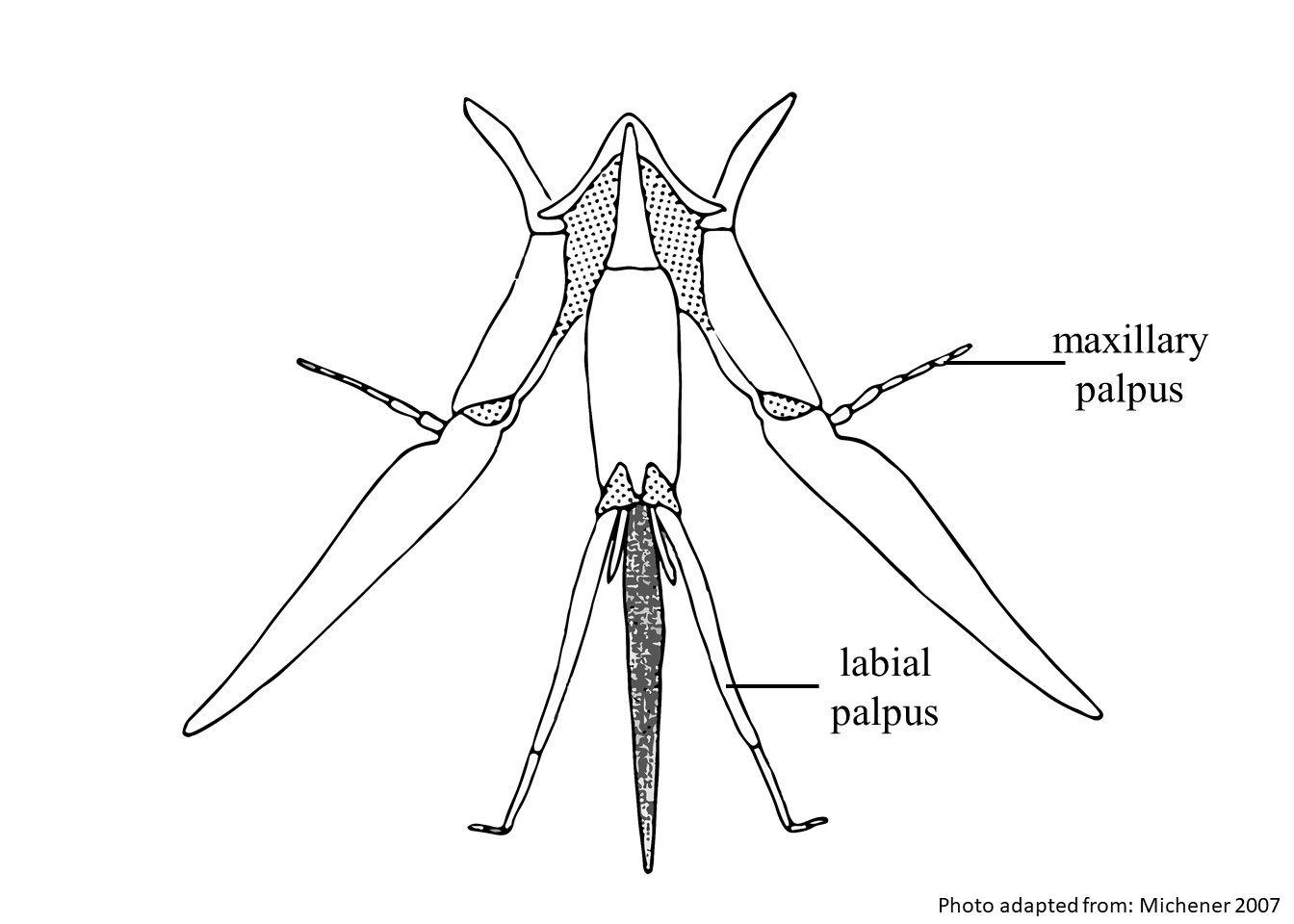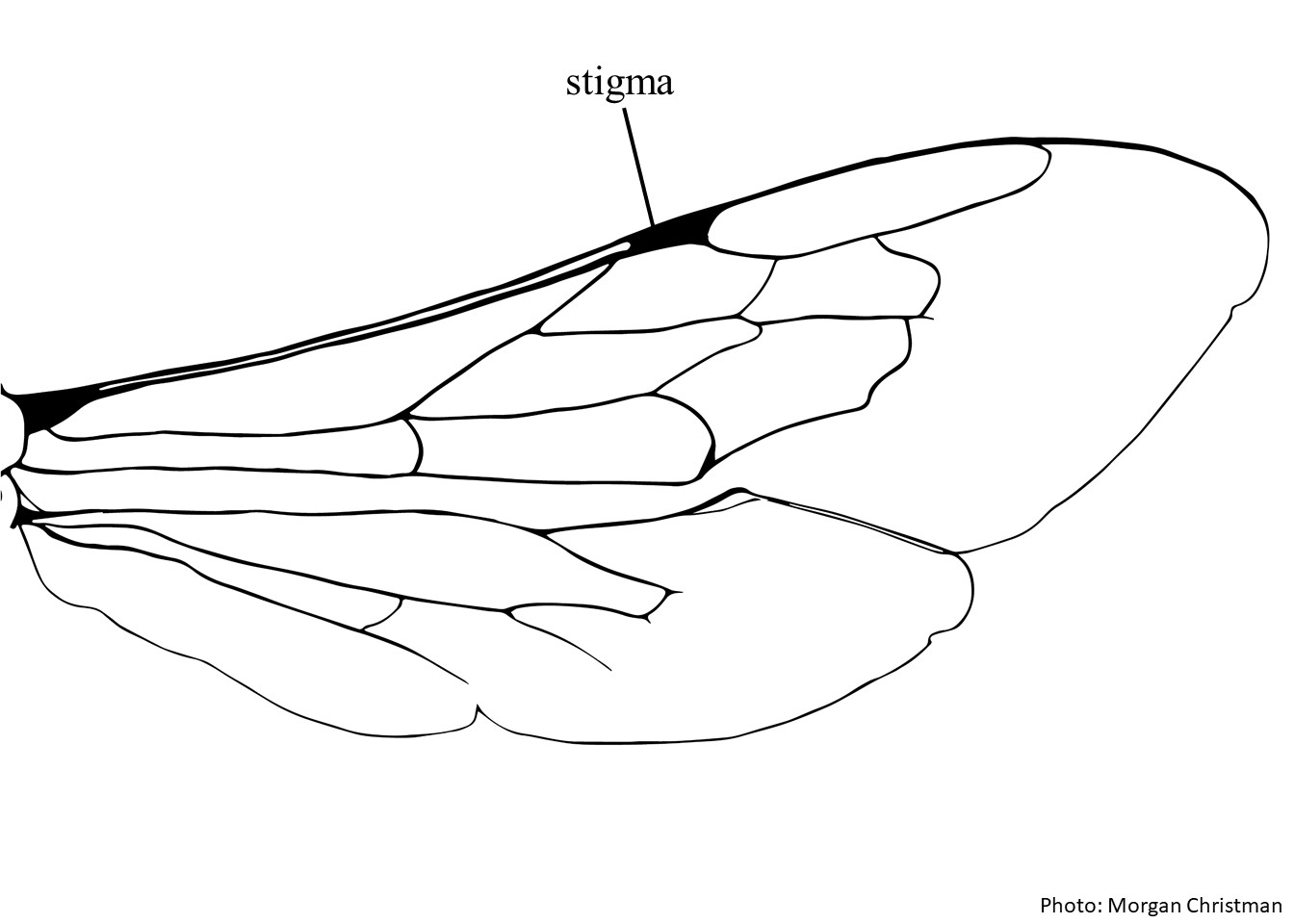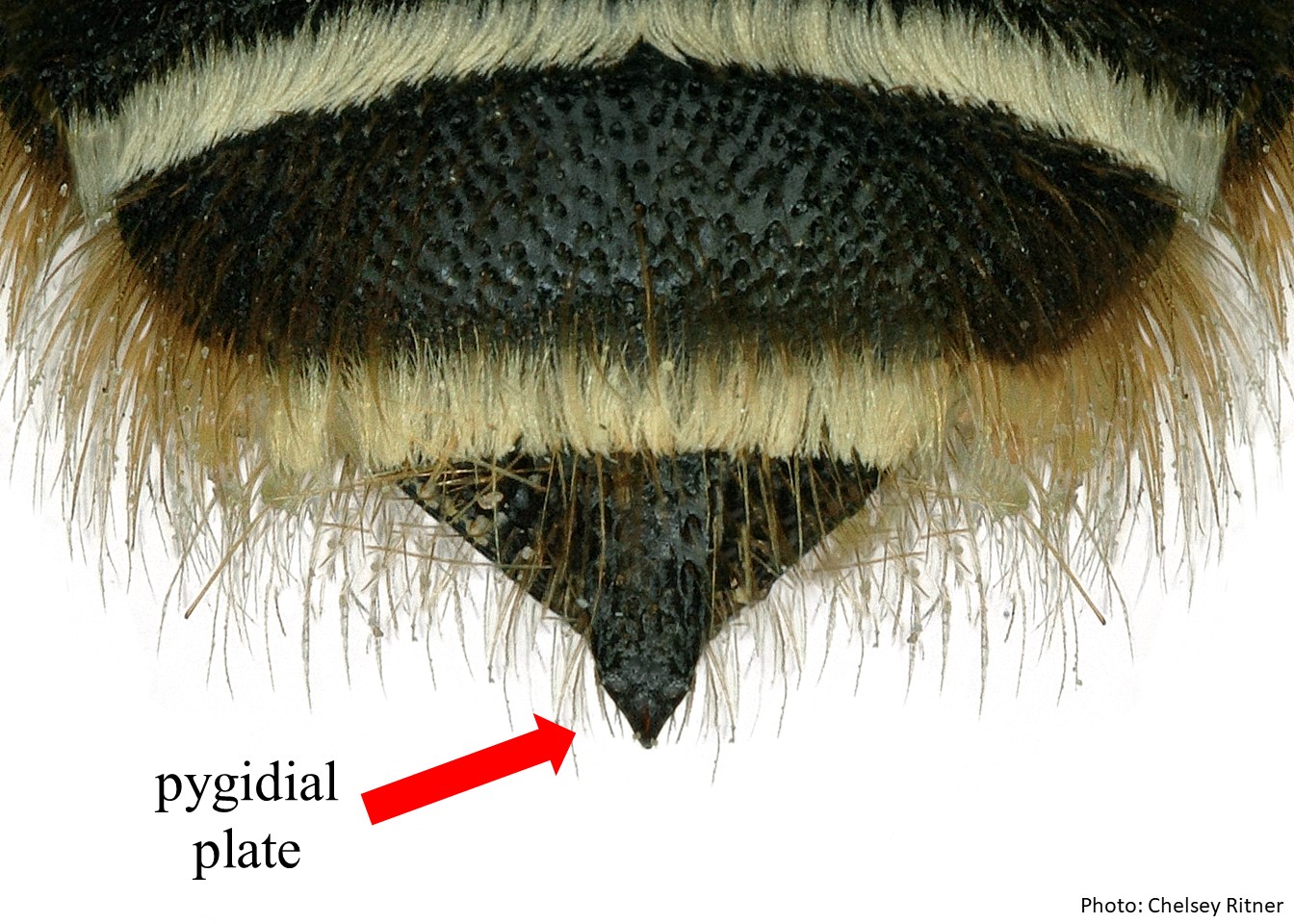There are eight separate keys associated with this tool. We have not included a key to family level identification because the characters used to distinguish between bee families are difficult to use and often hidden from view. Michener (2007) notes that it is usually easier to identify bees to tribe or genus than it is to identify them to family using a key. Many people familiar with bees associate them to family simply because they are familiar with the other genera included in that family. This unfortunately does not help those who are just getting started with bee identification. In order to facilitate identification, we have provided a list of characters below to help determine which Lucid key should be used for each of the groups included in this tool.
The bees included in this tool all belong to the two families of “long-tongue” bees, Megachilidae and Apidae. For bees, “long-tongue” means that the first two segments of the labial palpipalpi:
sensory appendages part of the labium and maxilla
 are elongate, flattened, and sheath-like (Michener 2007Michener 2007:
are elongate, flattened, and sheath-like (Michener 2007Michener 2007:
Michener, C.D. 2007. The Bees of the World (2nd ed.). Johns Hopkins University Press, Baltimore and London, 953 pp.).
Apis belong to the Apidae subfamily Apinae, which are the corbiculatecorbiculate:
applies to all the bees that have corbicula (and which are part of a natural group within bees in the subfamily Apinae)
Apidae (Michener 2007Michener 2007:
Michener, C.D. 2007. The Bees of the World (2nd ed.). Johns Hopkins University Press, Baltimore and London, 953 pp.). The presence of a corbiculacorbicula:
concave, smooth space, edged by a fringe of hairs arising from the margins of the hind tibia in bees, literally "basket" in Latin; its function is to hold the collected pollen in place
 on the hind tibiatibia:
on the hind tibiatibia:
the segment of the leg, between the femur and the tarsus distinguishes Apis females from most other bee genera. (Bombus, however, is another common genus with corbiculacorbicula:
concave, smooth space, edged by a fringe of hairs arising from the margins of the hind tibia in bees, literally "basket" in Latin; its function is to hold the collected pollen in place
 on the hind tibiatibia:
on the hind tibiatibia:
the segment of the leg, between the femur and the tarsus.) Features that can be used to separate Apis from the other Apinae genera are that they have hairy eyes, aroliaarolia:
the cushion-like pad between the tarsal claws found at the ends of some bees' legs
 are present between the tarsal claws, and they lack hind tibial spurs (Michener 2007Michener 2007:
are present between the tarsal claws, and they lack hind tibial spurs (Michener 2007Michener 2007:
Michener, C.D. 2007. The Bees of the World (2nd ed.). Johns Hopkins University Press, Baltimore and London, 953 pp.). Apis also have three submarginal cellssubmarginal cells:
one or more cells of the wing lying immediately behind the marginal cells, the marginal cellmarginal cell:
a wing cell located on the edge (margin) of the wing is long, nearly four times as long as the distance from its apexapex:
end of any structure
to the wingtip, and the stigmastigma:
a pigmented/ thickened spot on the costal margin of the forewing, usually at the end of the radius(Greek, stigma= mark) is small, the prestigmaprestigma:
is small, the prestigmaprestigma:
the expansion of the venation at the confluence of the costal/subcostal and radial sector veins basal of the prostigma
almost as long or longer (Michener 2007Michener 2007:
Michener, C.D. 2007. The Bees of the World (2nd ed.). Johns Hopkins University Press, Baltimore and London, 953 pp.).
Ceratina also belong to Apidae and belong to the subfamily Xylocopinae. Ceratina are generally small to medium-sized, somewhat cylindrical-shaped bees. Features that can be used to separate Ceratina from other genera include their antenna with F1 shorter than the length of F1 and F2 combined, forewings with three submarginal cellssubmarginal cells:
one or more cells of the wing lying immediately behind the marginal cells, jugal lobejugal lobe:
the inner most lobe of the hind wing, often set off from the the rest of the wing by a fold and a notch in the margin. The jugal lobe can be absent in some genera.
.jpg) of hind wing over one-third as long as the vannal lobevannal lobe:
of hind wing over one-third as long as the vannal lobevannal lobe:
often the secondmost inner lobe of the hind wing, usually set off from the the rest of the wing by a fold and a notch in the margin. The jugal lobe can be absent in some genera and in those cases the jugal lobe is the innermost lobe of the hind wing..jpg) , and the pygidial platepygidial plate:
, and the pygidial platepygidial plate:
unusually flat area (a plate) surrounded by a ridge or line and sometimes sticking well off of the end of the bee; if present, found on the sixth upper abdominal segment in females, seventh in males is absent. Females also have a labrumlabrum:
is absent. Females also have a labrumlabrum:
part of the head abutting the clypeus, folds down in front of the mouthparts
 that is broader than long, without basalbasal:
that is broader than long, without basalbasal:
originating at the foundation of a structure
elevated area, and their scopascopa:
modified hairs for carrying pollen; often branched and dense hairs on the hind-leg, or on the ventral surface of the abdomen in Megachilidae
is also greatly reduced, or absent, not forming a corbiculacorbicula:
concave, smooth space, edged by a fringe of hairs arising from the margins of the hind tibia in bees, literally "basket" in Latin; its function is to hold the collected pollen in place
 on the tibiatibia:
on the tibiatibia:
the segment of the leg, between the femur and the tarsus.
A majority of the Megachilidae genera can be separated from the other families of bees because the labrumlabrum:
part of the head abutting the clypeus, folds down in front of the mouthparts
 is longer than broad, with no apicalapical:
is longer than broad, with no apicalapical:
near or at the apex or end of any structure
process, and they have two submarginal cellssubmarginal cells:
one or more cells of the wing lying immediately behind the marginal cells on the wing (except for Fideliini, which have three). Most females can be readily identified by the presence of scopascopa:
modified hairs for carrying pollen; often branched and dense hairs on the hind-leg, or on the ventral surface of the abdomen in Megachilidae
on the ventralventral:
of, on, or relating to the underside of an animal, or segment of an animal
side of the abdomen, apart from cleptoparasiticcleptoparasitic:
bees that lay their eggs in the nest cells of bees in other genera. Their larvae depend on the pollen provided by their host. Since cleptoparasitic bees don't provision their own nests, and instead depend on the pollen collected by their host, the females lack pollen collecting hairs. This often gives them a wasp-like appearance.
genera (that lack pollen-collecting hairs) and Pararhophites (Michener 2007Michener 2007:
Michener, C.D. 2007. The Bees of the World (2nd ed.). Johns Hopkins University Press, Baltimore and London, 953 pp.).
Megachile s.l. represents an enormous group of bees that includes over 1,100 species (Michener 2007Michener 2007:
Michener, C.D. 2007. The Bees of the World (2nd ed.). Johns Hopkins University Press, Baltimore and London, 953 pp.). Over the years it has been separated in a number of ways. Michener (2007) treated them as a single genus but separated them into three groups. Since a good deal of change has happened in this group since 2007, and there is likely more change to come, in the Lucid key to the Megachilidae genera we included a majority of the genera and subgenera that Michener included under Megachile under the name Megachile s.l. and provided an additional key to the subgenera and genera in that group. This allows the Lucid keys to remain somewhat stable as generic and subgeneric changes continue to be made.
Bees in the genus Anthidium can be determined using the Megachilidae genera of the world key. The Anthidium subgenus key can be used to determine if you have a subgenus that is exotic to the U.S. Anthidium (Anthidium) is the only subgenus native to the western hemisphere. For species that belong to this subgenus, the Anthidium (Anthidium) species of North America key can be used to differentiate between species native to the U.S. and species that occur in Mexico and Central America, which is where most U.S. port of entry bee interceptions have been recorded from.
Bees in the genus Osmia can be determined using the Megachilidae genera of the world key. This guide currently includes keys to differentiate between the Osmia subgenera and determine species within the Osmia (Osmia) subgenus. We have chosen to include a species level identification guide for the O. (Osmia) because bees in this subgenus are commercially used around the world, and multiple species of O. (Osmia) have been introduced outside of their native range both intentionally and accidentally.
Select one of the keys below to begin: